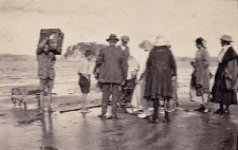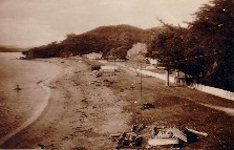THUMBNAIL HISTORY OF PAIHIA
TIME-LINE
| 1769 | Captain James Cook sails into this harbour and names it Bay of Islands. He finds it heavily populated by Maori and is impressed at their industry and intelligence. |
| 1772 | French explorer Marion du Fresne and crew members are killed and eaten by Maori. |
| 1793 |
Whaling and sealing vessels, learning from Cook's maps, begin to visit the Bay of Islands. Maori warriors join these ships and travel off shore. |
| 1809 | Visiting ship the Boyd is attacked and burned in Whangaroa and her crew eaten as utu (revenge) for mistreatment of a chief's son on one such voyage. |
| 1814 | Ruatara, another chief's son, ill from such treatment, is returned to his tribe at Te Puna in the Bay of Islands by Rev Samuel Marsden, who, based in Sydney, had nursed him back to health. Together, they establish New Zealand's first mission station. |
| 1819 | Marsden brings missionaries to Kerikeri to build the second Mission Station. |
| 1823 |
Paihia Mission Station, the third base, at the invitation of Chief Te Koki. Marsden brings in two young families, Henry and Marianne Williams with three small children and William and Sarah Fairburn, also with three small children. They live in a large four bedroomed whare on Paihia beach. |
| 1824 | Williams and Fairburn have built school and church and begin to build a sailing vessel on Paihia beach. This 55 ton ship takes two years to build. |
| 1824 |
Tohunga Tohitapu places a curse on Henry Williams. When Williams fails to die, Tohitapu then blesses Paihia village and it is never again attacked. |
| 1826 | Building of the Herald is completed and the vessel launched on Paihia beach. Many Maori attend. Alarmed when the great waka slides unaided down the slipway into the sea, they throw spears at it, crying "taniwha, taniwha" and many hakas break out. Missionary William Williams and his new wife Jane, arrive in Paihia. He joins his brother Henry, and translates the Bible into Maori. |
| 1829 |
Paihia is now a considerable village with dwellings for teachers, blacksmiths, carpenters. Kororareka (Russell) across the Bay, has become a lawless base for seamen. Local Maori call Paihia heaven and Kororareka hell. |
| 1833 |
James Busby is sent as British Resident to Paihia following increasing requests from Maori chiefs for some form of protection from possible French annexation.
Prior to leaving Sydney, James Busby purchases the farm at Waitangi from departing missionary, William Hall. Paihia, Maori and missionary welcome Busby with a large ceremony. |
| 1834 |
William Colenso brings printing press to Paihia. Together with William Williams, they print Maori Bibles. |
| 1835 |
James Busby introduces the Confederation of chiefs, designed to give Maori sovereignty of New Zealand. It fails through lack of support. |
| 1840 |
Captain William Hobson arrives in Paihia and liaises with the Missionaries. Together with Busby, he drafts the Treaty of Waitangi. William Colenso prints the documents in Paihia. Henry Williams is called on to translate for Maori. |
| 1843 |
Replacing Hobson, Govenor Fitzroy arrives in Paihia which over years has remained the administration centre as incoming officials rely on missionary knowledge of Maori and New Zealand. |
| 1844 |
Maketu murders the Roberton family on their island. Tried and hung. In Auckland, local chief Hone Heke is enraged. Broken treaty promises add to this and Heke cuts down the British flag at Kororareka. Paihia missionaries try to persuade Governor Fitzroy not to re-erect it and dissolve increasing tension. |
| 1845 |
Heke cuts down flagstaff for the fourth time and attacks Kororareka, burning it to the ground, leaving only the church and Pompallier house. Governor Grey replaces Fitzroy, brings in troops and the Northern wars begin.
British troops build a causeway across the Kaipatiki river to create a road from Paihia to Waimate. They transport their cannon inland. |
| 1848 | Disliking their power and mana with Maori, Governor Grey sets out to discredit Paihia Missionaries, targeting Henry Williams. Labelling him a traitor against the Crown for his support of Maori and condemning land purchases, he attacks Henry Williams in dispatches to Britain. |
| 1850 |
The Church Mission Society in London dismisses Henry Williams With his wife, he leaves Paihia to live at Pakaraka. |
| 1853 | Following petitions from Maori and missionaries, the Church Mission Society reverse this decision. He is made an Archdeacon. |
| 1856 |
William William's two storey house, built with bricks hand made with Paihia clay, is burnt down.
Paihia becomes remote and forgotten. |
| 1876 | Maori tribes build a monument to Henry Williams by the Paihia Church. |
| 1880 |
Whaling and kauri timber have become the Bay of Islands wealth. Paihia resident Tom Joyce builds and repairs whaling boats from his boat shed on Paihia beach. It can be seen today. |
| 1881 |
3000 Maori meet at Te Tiriti o Waitangi Marae to discuss failed Treaty issues. Delegations to London by Maori follow. |
| 1890 |
Williams family descendants plant a Norfolk pine tree on the site of the whare, built to house the Williams and Fairburn families in 1823.
William Lane starts the "Cream Trip" collecting cream cans from isolated Bay of Islands farms. |
|
Travel into and out of Paihia in 1914. |
Paihia Beach around 1914, prior to building of roads linking Paihia to the outside world. |
| 1915 |
Inland farming settlers build a wharf at the eastern end of Paihia beach. Until then, cattle were driven to Stockyard Bay (today's Sullivans Beach) to be held for transporting by coastal scow to the Auckland markets. Farmers drove their cattle to Paihia via the Kaipatiki causeway and along the three beaches. Cattle were swum out from the beach and hoisted by sling onto the decks. The wharf gave safer access to scows. Local Maori warned of cross currents at the chosen wharf site. The wharf washed away in a storm. Today, concrete girders lie on the rocks and the stone cattle entrance-race remains. |
| 1925 |
Engineer Mr Packwood surveys and builds the road from Puketona to Paihia and the Kaipatiki river is bridged.
Paihia Church is transported by barge up the Kawakawa river to Taumarere and Williams family descendants build a stone church.
Paihia's Williams House is built. |
| 1926 | Mr Fuller purchases Lane's cream trip run. |
| 1935 |
Governor General, Lord Bledisloe, holidays with Lady Bledisloe in Paihia. Local resident and MP, Vernon Reed, introduces them to Waitangi where Busby's house, scene of the 1840 treaty signings lies forgotten and run down.
Bledisloe purchases Waitangi and gifts it to the nation. |
| 1937-8 | Waitangi River is bridged. |
| 1940 |
New Zealand celebrates the Centenary of the Treaty of Waitangi signings.
A proclamation from the Church Mission Society in London is read out at these celebrations, exonerating Henry Williams from the charges made against him 90 years earlier and honouring his 44 years work amongst Maori. |
| 1941 |
Gun emplacements are built on Bay of Islands headlands under the threat of Japanese invasion. Barbed wire entanglement is placed along all Paihia beaches. |
| 1942 |
American forces based in the Bay of Islands build a road from Paihia to Kawakawa. |
| 1959 |
Prime Minister, Keith Holyoake, builds the Waitangi Tourist Hotel, and Paihia's first motels are built. The forgotten spot grows into today's tourist mecca. |
|
by Elizabeth Ludbrook |
|


